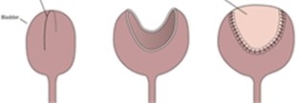Why is it done?
- This procedure is used less often these days with the more frequent use of sacro neuromodulation and intravesical BOTOX
- This procedure is done to enlarge a bladder, especially in the spinal patient with a small contracted overactive bladder.
- It can also be done as last resort in small overactive bladder after all other medical options have failed.
How is it done?
- A general anesthetic will be given
- You would have had bowel preparation for 3 days prior to surgery.
- A sterile surgical field is prepared
- Prophylactic antibiotics are given.
- An indwelling catheter is inserted, and the bladder is then distended with fluid (saline).
- A lower abdominal incision is made, splitting the Linea alba.
- A 15-20cm segment of the terminal ileum is isolated and removed from the rest of the intestinal tract on its vascular pedicle.
- A watertight anastomosis of the bowel ends is done and tested.
- The bladder is then bi-valved.
- The 15cm of ileum is opened on the anti-mesenteric edge and the bowel in cleaned.
- The ileum-segment is then sewn on to the bi-valved bladder.
- A 3-way catheter is placed
- A drain is left.
- The abdomen and skin are closed
- A catheter will be left for 2 weeks
Complications
Side–effects
- Rarely blood loss requiring a blood transfusion.
- Infection, Peritonitis.
- Fecal leak from small bowel anastomosis
- Prolonged hospital stays.
- Urine leak requiring prolonged catheterization,
- NB! Each person is unique and for this reason symptoms vary!
What next?
- You will spend up to 5-7 nights in hospital.
- You will have a catheter for 14 days.
- A drain for 2-3 days.
- You will be discharged as soon as you are drain free, temperature free and have opened your bowels.
- You may initially suffer from urge symptoms caused by the catheter.
- There may be some blood in your urine. You can remedy this by drinking plenty of fluids until it clears.
- A ward prescription will be issued on your discharge, for your own collection at any pharmacy
- A follow-up appointment will be scheduled for 2 weeks for a cystogram.
- Should the cystogram confirm to urine leaks, your catheter will be removed.
- A review appointment is scheduled 6 weeks later
- Don’t hesitate to ask Jo if you have any queries
- DON’T SUFFER IN SILENCE, OR YOU WILL SUFFER ALONE!
Download Information Sheet
Copyright 2019 Dr Jo Schoeman

